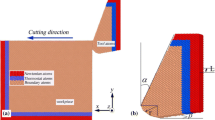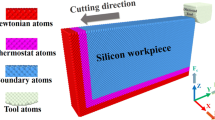Abstract
In nanometric cutting, the dominant material removal mechanism can be greatly different with macroscopic cutting process. In this work, molecular dynamics (MD) simulation was carried out to investigate the cutting features of single-crystal silicon. The effect of the tool rake angle and the workpiece crystal orientation on the transition of the material removal mechanism was studied. Theoretical analysis and cutting experiments were conducted to verify the simulation results. The results indicate that with a decrease of the tool rake angle, the material removal mechanism could transform from shear to extrusion and finally no material would be removed. In this process, the position of the stagnation region increases rapidly when the dominant material removal mechanism becomes extrusion and would reache to the uncut surface when no material is removed. The shear to extrusion transition is greatly influenced by the tool rake angle and workpiece crystal orientation while the dominant factor that affect the transition from extrusion to no removal is the position of the stagnation region and frictional force on tool rake face. Furthermore, based on the simulation results and theoretical analysis, when the tool rake angle is decreased, the shear stress plays an important role in the formation of the subsurface damage.













Similar content being viewed by others
Data availability
The data sets supporting the results of this article are included within the article and its additional files.
References
Zong WJ, Sun T, Li D, Cheng K, Liang YC (2008) XPS analysis of the groove wearing marks on flank face of diamond tool in nanometric cutting of silicon wafer. Int J Mach Tools Manuf 48:1678–1687
Zhang L, Zhao H, Ma Z, Huang H, Shi C, Zhang W (2012) A study on phase transformation of monocrystalline silicon due to ultra-precision polishing by molecular dynamics simulation. AIP Adv 2:042116
Fang FZ, Venkatesh VC (1998) Diamond cutting of silicon with nanometric finish. CIRP Ann Manuf Techn 47:45–49
Jiwang Yan KS (2002) Tsunemoto Kuriyagawa, Hirofumi Suzuki, Ductile regime turning at large tool feed. J Mater Process Technol 121:363–372
Shibata T, Fujii S, Makino E, Ikeda M (1996) Ductile-regime turning mechanism of single-crystal silicon. Precis Eng 18:129–137
Liu B, Fang F, Li R, Xu Z, Liang Y (2018) Experimental study on size effect of tool edge and subsurface damage of single crystal silicon in nano-cutting. Int J Adv Manuf Technol 98:1093–1101
Wojciechowski S, Nowakowski Z, Majchrowski R, Królczyk G (2017) Surface texture formation in precision machining of direct laser deposited tungsten carbide. Adv Manuf 5:251–260
Yan J, Asami T, Harada H, Kuriyagawa T (2012) Crystallographic effect on subsurface damage formation in silicon microcutting. CIRP Ann Manuf Techn 61:131–134
Mir A, Luo X, Cheng K, Cox A (2018) Investigation of influence of tool rake angle in single point diamond turning of silicon. Int J Adv Manuf Technol 94:2343–2355
Peter RS, Blake N (1990) Ductile-regime machining of germanium and silicon. J Am Ceram Soc 73:949–957
Leung WBLTP, Lu XM (1998) Diamond turning of silicon substrates in ductile-regime. J Mater Process Technol 73:42–48
Krulewich Born D, Goodman WA (2001) An empirical survey on the influence of machining parameters on tool wear in diamond turning of large single-crystal silicon optics. Precis Eng 25:247–257
Durazo-Cardenas I, Shore P, Luo X, Jacklin T, Impey SA, Cox A (2007) 3D characterisation of tool wear whilst diamond turning silicon. Wear 262:340–349
Yan J, Asami T, Harada H, Kuriyagawa T (2009) Fundamental investigation of subsurface damage in single crystalline silicon caused by diamond machining. Precis Eng 33:378–386
Wang M, Wang W, Lu Z (2011) Anisotropy of machined surfaces involved in the ultra-precision turning of single-crystal silicon—a simulation and experimental study. Int J Adv Manuf Technol 60:473–485
Chen YL, Cai Y, Shimizu Y, Ito S, Gao W, Ju BF (2016) Ductile cutting of silicon microstructures with surface inclination measurement and compensation by using a force sensor integrated single point diamond tool. J Micromech Microeng 26:025002
Wojciechowski S, Matuszak M, Powałka B, Madajewski M, Maruda RW, Królczyk GM (2019) Prediction of cutting forces during micro end milling considering chip thickness accumulation. Int J Mach Tools Manuf 147:103466
Przestacki D, Chwalczuk T, Wojciechowski S (2017) The study on minimum uncut chip thickness and cutting forces during laser-assisted turning of WC/NiCr clad layers. Int J Adv Manuf Technol 91:3887–3898
Yuan Y, Jing X, Ehmann KF, Cao J, Li H, Zhang D (2018) Modeling of cutting forces in micro end-milling. J Manuf Process 31:844–858
Heidari M, Akbari J, Yan J (2019) Effects of tool rake angle and tool nose radius on surface quality of ultraprecision diamond-turned porous silicon. J Manuf Process 37:321–331
Liu H, Xie W, Sun Y, Zhu X, Wang M (2018) Investigations on brittle-ductile cutting transition and crack formation in diamond cutting of mono-crystalline silicon. Int J Adv Manuf Technol 95:317–326
Zhang J, Han L, Zhang J, Li G, Xu J, Yan Y, Sun T (2019) Finite element analysis of the effect of tool rake angle on brittle-to-ductile transition in diamond cutting of silicon. Int J Adv Manuf Technol 104:881–891
Zhang S, Zhang H, Zong W (2019) Modeling and simulation on the effect of tool rake angle in diamond turning of KDP crystal. J Mater Process Technol 273:116259
Goel S, Kovalchenko A, Stukowski A, Cross G (2016) Influence of microstructure on the cutting behaviour of silicon. Acta Mater 105:464–478
Dai H, Zhang F, Chen J (2019) A study of ultraprecision mechanical polishing of single-crystal silicon with laser nano-structured diamond abrasive by molecular dynamics simulation. Int J Mech Sci 157-158:254–266
Zhao L, Zhang J, Zhang J, Hartmaier A (2021) Atomistic investigation of machinability of monocrystalline 3C–SiC in elliptical vibration-assisted diamond cutting. Ceram Int 47:2358–2366
Goel S, Luo X, Reuben RL, Pen H (2012) Influence of temperature and crystal orientation on tool wear during single point diamond turning of silicon. Wear 284-285:65–72
Xiao G, S. To, Zhang G (2015) Molecular dynamics modelling of brittle–ductile cutting mode transition: case study on silicon carbide. Int J Mach Tools Manuf 88:214–222
Dai H, Chen G, Fang Q, Yin J (2016) The effect of tool geometry on subsurface damage and material removal in nanometric cutting single-crystal silicon by a molecular dynamics simulation. Appl Phys A Mater Sci Process 122:804
Wang Z, Chen J, Wang G, Bai Q, Liang Y (2017) Anisotropy of single-crystal silicon in nanometric cutting. Nanoscale Res Lett 12:300
Abdulkadir LN, Abou-El-Hossein K (2019) Diamond tool wear mode, path and tip temperature distribution considering effect of varying rake angle and duncut/Redge ratio. Surf Topogr: Metrol Prop 7:025011
Xie W, Fang F (2020) Rake angle effect in cutting-based single atomic layer removal. J Manuf Process 56:280–294
Alhafez IA, Urbassek HM (2020) Influence of the rake angle on nanocutting of Fe single crystals: a molecular-dynamics study. Crystals 10:516
Xu Y, Wang M, Zhu F, Liu X, Chen Q, Hu J, Lu Z, Zeng P, Liu Y (2019) A molecular dynamic study of nano-grinding of a monocrystalline copper-silicon substrate. Appl Surf Sci 493:933–947
Feng R, Qi Y, Zhu Z, Song W, Li H, Wang M, Rui Z, Gu F (2020) Molecular dynamics simulation to investigate the rake angle effects on nanometric cutting of single crystal Ni3Al. Int J Precis Eng Manuf 21:711–724
Plimpton S (1995) Fast parallel algorithms for short-range molecular dynamics. J Comput Phys 117:1–19
Alexander S (2010) Visualization and analysis of atomistic simulation data with OVITO-the Open Visualization Tool. Model Simul Mater Sci Eng 18:015012
Maras E, Trushin O, Stukowski A, Ala-Nissila T, Jónsson H (2016) Global transition path search for dislocation formation in Ge on Si(001). Comput Phys Commun 205:13–21
Erhart P, Albe K (2005) Analytical potential for atomistic simulations of silicon, carbon, and silicon carbide. Phys Rev B 71:035211
Goel S, Luo X, Agrawal A, Reuben RL (2015) Diamond machining of silicon: a review of advances in molecular dynamics simulation. Int J Mach Tools Manuf 88:131–164
Chavoshi SZ, Luo X (2016) An atomistic simulation investigation on chip related phenomena in nanometric cutting of single crystal silicon at elevated temperatures. Comput Mater Sci 113:1–10
Guo X, Li Q, Liu T, Zhai C, Kang R, Jin Z (2016) Molecular dynamics study on the thickness of damage layer in multiple grinding of monocrystalline silicon. Mater Sci Semicond Process 51:15–19
Dai H, Chen G, Zhou C, Fang Q, Fei X (2017) A numerical study of ultraprecision machining of monocrystalline silicon with laser nano-structured diamond tools by atomistic simulation. Appl Surf Sci 393:405–416
Cai MB, Li XP, Rahman M (2007) Characteristics of “dynamic hard particles” in nanoscale ductile mode cutting of monocrystalline silicon with diamond tools in relation to tool groove wear. Wear 263:1459–1466
Fang FZ, Wu H, Liu YC (2005) Modelling and experimental investigation on nanometric cutting of monocrystalline silicon. Int J Mach Tools Manuf 45:1681–1686
Fang FZ, Wu H, Zhou W, Hu XT (2007) A study on mechanism of nano-cutting single crystal silicon. J Mater Process Technol 184:407–410
Liu B, Xu Z, Chen C, Pang K, Wang Y, Ruan Q (2019) Effect of tool edge radius on material removal mechanism of single-crystal silicon: numerical and experimental study. Comput Mater Sci 163:127–133
Wang J, Zhang X, Fang F, Chen R (2018) A numerical study on the material removal and phase transformation in the nanometric cutting of silicon. Appl Surf Sci 455:608–615
Dai H, Zhang F, Zhou Y (2020) Numerical study of three-body diamond abrasive polishing single crystal Si under graphene lubrication by molecular dynamics simulation. Comput Mater Sci 171:109214
Chavoshi SZ, Goel S, Luo X (2015) Molecular dynamics simulation investigation on the plastic flow behaviour of silicon during nanometric cutting. Model Simul Mater Sci Eng 24:015002
Xu F, Fang F, Zhang X (2017) Hard particle effect on surface generation in nano-cutting. Appl Surf Sci 425:1020–1027
Xu F, Fang F, Zhang X (2018) Effects of recovery and side flow on surface generation in nano-cutting of single crystal silicon. Comput Mater Sci 143:133–142
Yoffe EH (2006) Elastic stress fields caused by indenting brittle materials. Philos Mag A 46:617–628
Ghosh D, Subhash G, Radhakrishnan R, Sudarshan TS (2008) Scratch-induced microplasticity and microcracking in zirconium diboride–silicon carbide composite. Acta Mater 56:3011–3022
Farris TN, Ahn Y, Chandrasekar S (1998) Sliding microindentation fracture of brittle materials: role of elastic stress fields. Mech Mater 29:143–152
Funding
Xiao Chen received support from the National Natural Science Foundation of China (grant no. 51905195) and Innovation Group Project of Hubei Provincial Natural Science Foundation (grant no. 2017CFA003). Jianguo Zhang received original support from the National Natural Science Foundation of China (No. 51905194) and the Wuhan Science and Technology Plan in China (No. 2019010701011400).
Author information
Authors and Affiliations
Contributions
Changlin Liu: conceptualization, methodology, software, writing—original draft preparation. Jianning Chu: methodology, software. Jianguo Zhang: visualization, investigation, data curation. Junjie Zhang: writing—reviewing and editing. Xiao Chen: software. Junfeng Xiao: writing—reviewing and editing. Jianfeng Xu: supervision.
Corresponding author
Ethics declarations
Ethical approval
Not applicable.
Consent to participate
Not applicable.
Consent for publication
Not applicable.
Competing interests
The authors declare no competing interests.
Additional information
Publisher’s note
Springer Nature remains neutral with regard to jurisdictional claims in published maps and institutional affiliations.
Rights and permissions
About this article
Cite this article
Liu, C., Chu, J., Zhang, J. et al. Effect of tool rake angle on the material removal mechanism transition of single-crystal silicon: a molecular dynamics study. Int J Adv Manuf Technol 115, 3631–3644 (2021). https://doi.org/10.1007/s00170-021-07391-x
Received:
Accepted:
Published:
Issue Date:
DOI: https://doi.org/10.1007/s00170-021-07391-x




